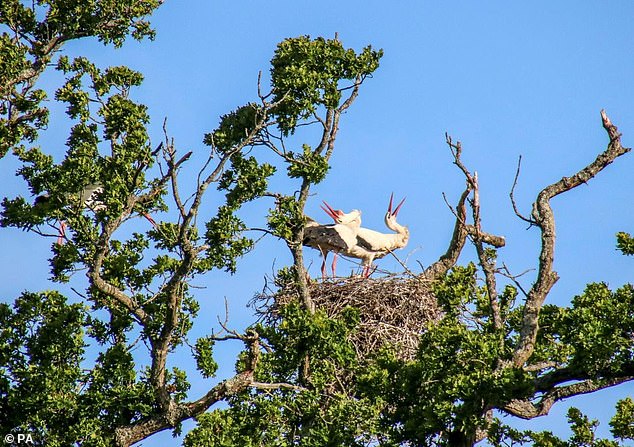|
For generations, they have been associated with new life and the pitter-patter of tiny feet.
But storks are now enjoying their own population boom amid a conservation project that has seen them return to English skies for the first time in centuries.
The White Stork Undertaking, which is based at the Knepp Property in West Sussex, has 25 native storks that have chosen to winter in the UK.
The birds laid eggs for the first time in 2020 and conservationists say the numbers are approaching a “critical mass” that could see the birds finally recover to numbers not seen in centuries.
This year, 53 chicks fledged at Knepp (double the previous year’s 26), giving high hopes that storks will begin to recolonise other parts of England.
The secret to Knepp’s success is the creation of a colony of more than 20 flightless storks rescued from accidents with power lines and roads in Poland.
These are kept in a six-acre pen in the middle of the reclamation project. This helps attract wild birds from Europe and also gives the free-flying Knepp’s storks, descendants of the penned birds, confidence and security in numbers.
The White Stork Undertaking, which is based at the Knepp Property in West Sussex, has 25 native storks that have chosen to winter in the UK.
As well as spreading their wings in the air, overwintering white storks can be found following Tamworth pigs and longhorn cattle around the rebuilding estate, following them in search of worms unearthed in the disturbed soil.
Isabella Tree, co-founder of the 3,500-acre Knepp rewilding project with her husband Charlie Burrell, said:
“The project has been a surprising success and we have been surprised by how quickly it has happened.” We haven’t had white storks breeding here for at least 600 years.
‘This is a real milestone. The last recorded nest that we believe was successful was at St Giles Catherdral, Edinburgh, in 1416.
“So bringing them back to Britain has been incredible.” He explained that rescued injured and flightless birds living in the pen in England attract some of the 20 to 40 birds that scout England for nesting sites in the United Kingdom.
‘These wounded birds in a pen create, if you like, a false colony, a peace of mind for the birds that come from the continent.
Captive-bred juvenile white stork (Ciconia ciconia) in flight over the Knepp Estate shortly after its release in August 2019
Explaining the success of the project, he said: ‘We now have very mild winters and we have some birds that will stay all winter, I suppose because of climate change.
“It is lovely to see these birds, they nest in the tops of oak trees and even in winter they see the resident storks. “Those that have decided to stay are very territorial and cling to the nests they need.”
“It’s amazing to hear this incredible noise they make, and they are very prehistoric when they fly, they almost look like a pterodactyl.”
Of Knepp’s stork colony he said: “You need a critical mass, the storks have to be able to fend for themselves and protect their eggs and chicks from crows, rooks, vultures and all sorts of things.”




